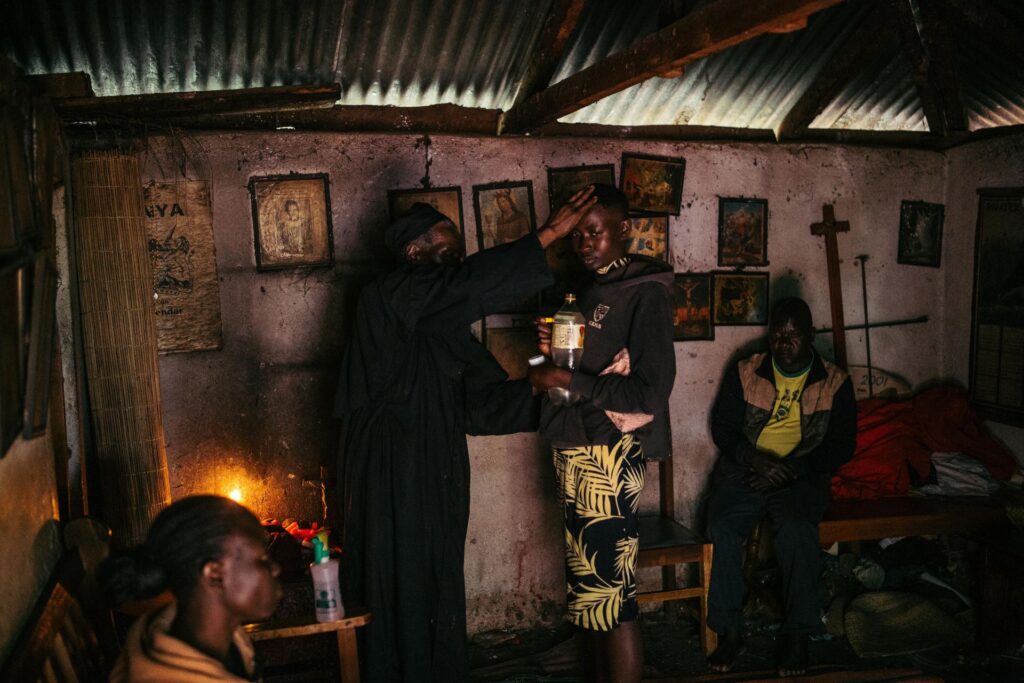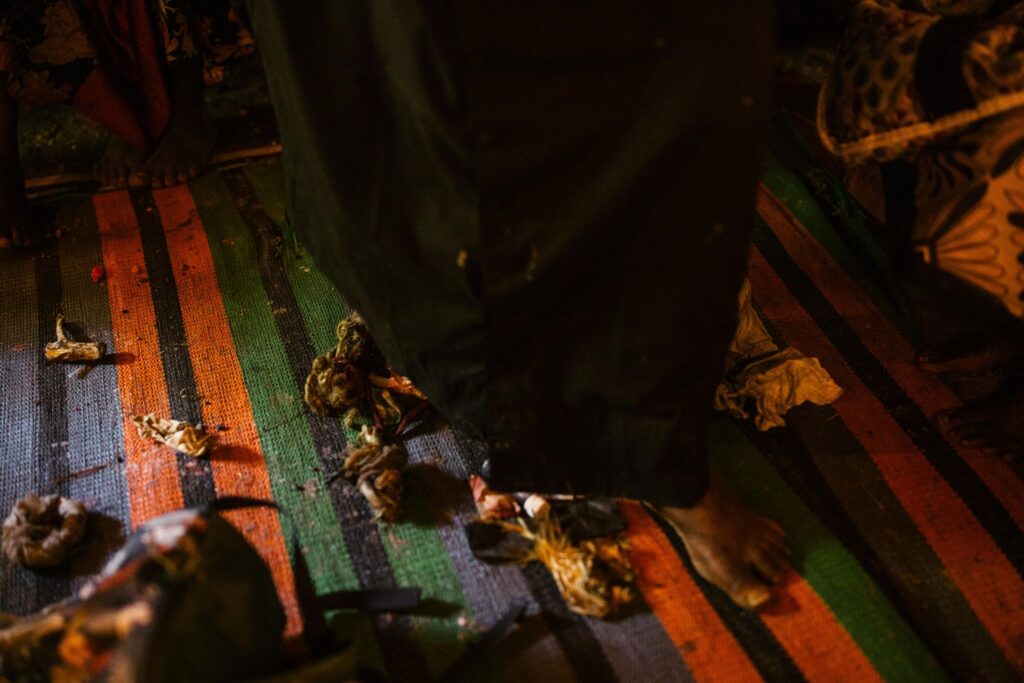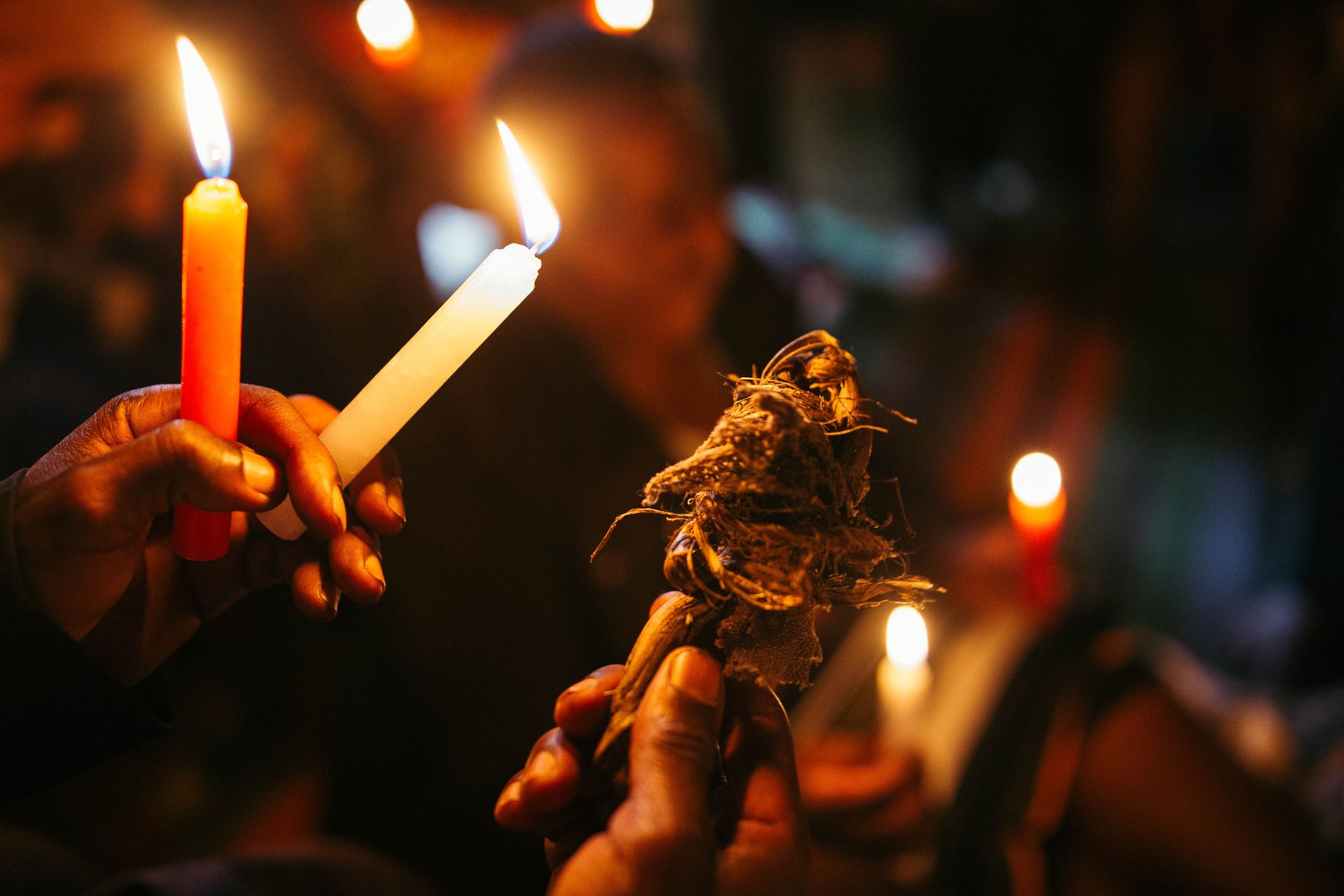Inside the hut, the air is cool from the clay walls. A smoldering fire and hand-held candles light the faces of the 15 or so folks gathered in the home of 82-year-old Clement Shiramba, a respected seer. Since his youth, Shiramba has earned a reputation as someone bestowed with divine wisdom, able to reveal insights to those who seek his expertise. For decades, he has worked to hone this craft.
Shiramba’s home is in Shinyalu, a village bordering the Kakamega Forest, Kenya’s last patch of tropical rainforest. Walking along a forest path, dense with tangled vines and jewel-green leaves, one could hear birdsong and the snapping of leaves as a monkey dashed from branch to branch. It had rained recently, the red clay scent pungent. At present, the forest is a mere 77 square miles, a remnant of the once magnificent Guineo-Congolian rainforest that spanned the African continent, from Guinea’s Atlantic Coast in the west through the Congo Basin to the Indian Ocean in the east.
For decades, the fate of the Kakamega Forest has faltered. It has been left to the mercy of a corrupt and brutal national forest service that is officially tasked with ecological conservation but instead converts old-growth forests into monoculture plantations for timber harvesting, and allegedly commits extrajudicial killings and violently evicts local people.
Kakamega County, within which the rainforest is located, is among Kenya’s most impoverished, with a rapidly growing population and few economic opportunities. The forest is degrading at an alarming rate, averaging a decline in tree cover of at least 8.4% from 2001 to 2022. Over those two decades, Shinyalu, a small township in eastern Kakamega, suffered the most tree cover loss — more than 2,000 acres.
Some local community members and grassroots organizations, such as the Kakamega Environmental Education Programme (KEEP), are scrambling to preserve their dwindling forest. By teaching locals the importance of a healthy ecosystem and illustrating the consequences of deforestation — air and water pollution, less shade and shelter from wind, biodiversity sterility — such groups are slowly reengaging communities with their natural environment. KEEP also spearheads educational programs in local schools, taking students on nature walks to observe and appreciate what their local environment has to offer.
Besides forcing 286,000 people in Kenya to migrate and contributing to wildlife extinction, climate change has led to increased joblessness in already impoverished counties like Kakamega. A 2017 United Nations Environmental Program report found that Kenya loses about 175,000 acres of forest to illegal logging each year.
Octogenarian Anastancia Nanguri, who has lived in Shinyalu her entire life and witnessed the collapse of the colonial government and Kenya’s independence, says that year after year, she sees the forest being depleted.
“A long time ago, every tree had a purpose,” she said over tea and bread in her living room, which is right on the edge of the Kakamega. The trees provided natural windbreaks or were carefully harvested for medicine. “[Most] people don’t recognize that anymore.”
The forest cover that the Kenya Forest Service (KFS) has regenerated in some parts is mostly superficial, Nanguri continues. “Medicinal trees are no longer there.” The nonnative eucalyptus trees, for instance, don’t serve any purpose, nor do they fit into the natural ecosystem. She’s not happy about it. Nanguri has imparted to her son, Pius Khalumi, her reverence for the Kakamega. Although he grew up during an era when communities’ relationships with their environment were rapidly weakening, he understands the intrinsic value of native species and why it’s critical to teach locals that the Kakamega is important.
“When you don’t own the forest, you have no incentive to safeguard it,” he explained. “We need to find a system of ownership, so [the community] won’t harm the forest, which they can benefit from.”

To Shiramba the seer, the Kakamega Forest and his work are intertwined. The forest is not only the source of cultural importance to local Luhya communities (a Bantu people and the second-largest ethnic group in Kenya) — community leaders were appointed before sacred trees — but also where unique indigenous herbs and roots grow. There’s the African mahogany (Khaya anthotheca): When consumed, it lowers cholesterol levels and cleanses the circulatory system, helping fatigued patients regain their appetites. And there’s the stinging nettle (Urtica dioica), which can be boiled into tea to cure gout.
During the ritual, the seer addressed everyone in turn. There was no need for him to question one’s reason for visiting, he just knew. Shiramba said to one woman that she needed to manage her jealousy — it was eating into her life. You have to control those feelings before they cause real destruction, Shiramba told her. Another woman was told that someone had cursed her from having children, but the blessings that the seer bestowed on her would ward away the evil energy.
When the seer turned to me, he asked me how my back and knees were feeling. There was some pain, I admitted, but that wasn’t the real issue. I had desperately wanted to seek Shiramba’s advice for insomnia so persistent it felt like it was ruining my life. Since the first quarter of the year, I couldn’t sleep more than a couple of hours each night, for days on end. Although sleep issues are commonplace in our modern world, I was at my wits’ end. Seeking advice from someone as experienced and revered as this seer could surely do no harm.

Shiramba peered into my eyes, saying that there was someone in a past life, knocking on my door at night and preventing my soul from resting. He picked up a framed painting of an armed angel overpowering a devilish-looking character. It’s something like this demon that is disturbing you, he told me. But don’t worry — I’ve prayed for you to cleanse you of that bad energy. Although a strong believer in traditional Luhya lore, Shiramba is also a Christian. He doesn’t see these religions as being in opposition to each other but complementary.
At the end of the ceremony, he prayed for us once more, waving his hands over a dirty-looking rag. After mumbling some incantations, he shook the rag hard and out tumbled an amalgamation of objects: money, empty medicine packets, filthy pieces of cloth. “That signifies what he’s cleansed us of,” Abraham Shiramba (no relation to the seer), who grew up in a neighboring village, whispered to me, explaining the process. My jaw dropped. I hadn’t expected this bit of magic.

Minutes later, it was all over. Those with the means gifted Clement Shiramba with some money, although seers generally don’t charge for their services. Many lined up for one last personal blessing, a dab of holy water from a plastic spray bottle along with a prayer. One man, who had been told that he had been praying for relief from paralyzing back pain, which would sort out his frustration and help him with his job, said that he came to the seer since he had run out of options. “My mother used to go to seers, and now I do too,” he said. Out in the bright, late morning sunlight, I blinked, feeling like I had emerged from a fever dream.
That night, I slept peacefully for the first night in months, without any drugs.
Kakamega’s seers are familiarizing patients with a holistic respect for their environment, one that stems from a traditional worldview: that what one needs to heal can be found within the natural environment, by listening to oneself. The seers follow careful systems for foraging for roots, leaves and berries, taking no more than what their patients need. It’s a localized system based on respect and understanding one’s place within the natural world.
This is in stark contrast to the Western and KFS approach of dominating and manipulating the environment, which includes replacing old-growth forests with sterile monoculture plantations of nonnative eucalyptus, pine or wattle wood trees destined for future logging.
Seers are offering patients an alternative form of treatment, whether it’s with psychological support or herbs. Some are disillusioned with Western pharmaceuticals; others are driven by a curiosity to return to traditional means when modernity feels more precarious than ever. “You’ll see some driving from Nairobi in their fancy cars,” Abraham said. “People who work in politics.”
This is rekindling people’s faith in traditional powers and opening eyes to the gifts found within forests such as the Kakamega — a “living pharmacy,” as Abraham, an environmental educator at KEEP, calls it. In turn, this strengthens people’s buy-in to protect the precious remaining swath of their indigenous forest.
“Being an herbalist is a skillset that is passed down,” Abraham explained earlier that morning while strolling along a forest path and stopping occasionally to examine a bud or cradle a branch. “Potential herbalists [when they are young] might be given a test, to fetch certain kinds of plants.” The promising ones then learn slowly, through years of working with the experienced.
Victoria Khamweche is an 80-year-old herbalist who learned the trade from her father. She gathers the majority of her medicines from three different sites in the eastern and northeastern segments of the Kakamega Forest. The arduous process, from long bus rides to warding off snakes in the forest, can take as long as a week in some of the farther plots, she tells me through Abraham, who translated for me. “I have clients who come from as far as Mombasa and Nairobi when hospitals aren’t able to help them,” she told us.
Although as an elderly and respected medicine woman Khamweche circumvents issues with KFS, many are not so lucky. It’s common to hear of extrajudicial killings carried out by government officials or police when bankrupt young men are caught illegally harvesting firewood. Khamweche says that in recent years it’s been difficult to source the plants she needs. The forest isn’t what it once was.
Abraham himself is a self-taught ornithologist and botanist, reeling off the Latin, English and Luhya names of countless birds and plants in the Kakamega. He learned through collaborations with the National Museums of Kenya and KFS, reading scientific books and being taught by herbalists. Understanding how this ecosystem fits together has shown him why it’s vital to preserve what’s left of the native Kakamega, otherwise, the health of both people and the environment will inevitably suffer. “We largely depend on the forest for survival,” he told me. “But we’re also the biggest source of pressure on the forest.”
Become a member today to receive access to all our paywalled essays and the best of New Lines delivered to your inbox through our newsletters.



